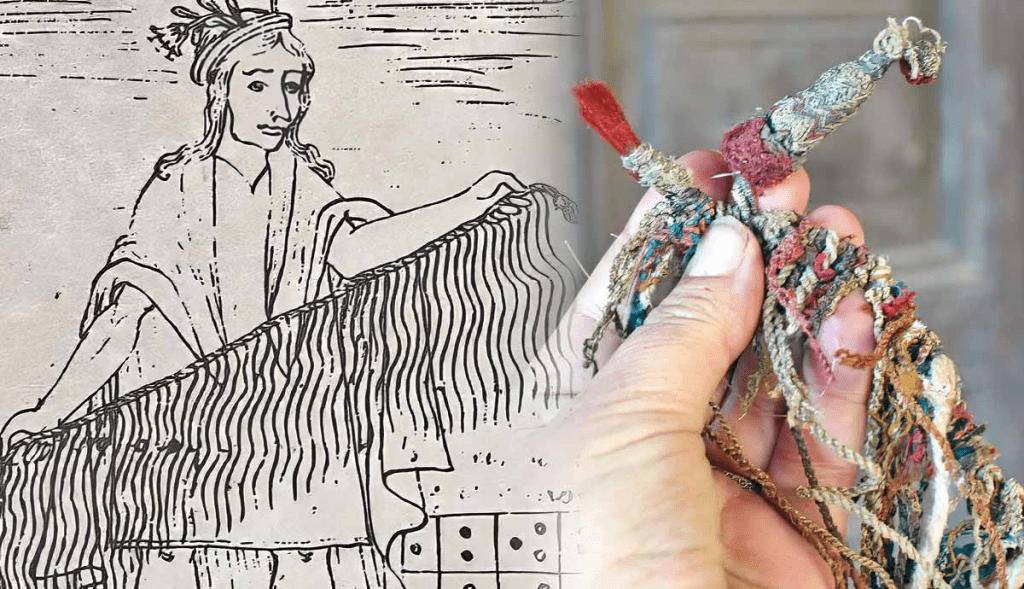When we think of great civilizations, we often imagine scrolls of ancient texts, stone carvings, or painted manuscripts detailing laws, trade, and stories. But the mighty Inca Empire at its height, one of the largest and most powerful in the world ruled over more than 12 million people without a traditional writing system. Instead, they relied on something far more mysterious: knotted cords called khipus.
This remarkable system helped them govern vast stretches of South America, from the Andes to the Pacific Coast, all without ever putting pen to paper. So how did they manage it? And what secrets do these strange cords still hold?

What Exactly Is a Khipu?
A khipu (also spelled quipu) was essentially a bundle of cords, made of cotton or alpaca wool, hanging from a main string. Each secondary cord held a series of knots tied in different positions, sizes, and patterns. At first glance, it might look like a tangled mess of strings. But for the Incas, it was a highly organized and meaningful tool.
Think of it like an ancient spreadsheet but instead of numbers on a screen, the data was woven and knotted by hand.

A Sophisticated System for a Sophisticated Empire
The Inca Empire, which thrived in the 15th and early 16th centuries, stretched across much of modern-day Peru, Ecuador, Bolivia, Chile, and Argentina. It was a complex, organized society that managed huge construction projects, maintained a massive army, collected taxes, and tracked agricultural yields.
Since they didn’t have a written alphabet or books, they needed another way to store and share vital information across their mountainous empire. That’s where khipus came in.
Video:
The Quipus Code: How the Incas Communicated with Knots
Each khipu was designed to record specific information. For example:
- Tax records showed what goods or labor people owed to the state.
- Census data tracked population counts, age groups, and family units.
- Agricultural reports detailed how much corn, potatoes, or quinoa had been harvested.
These cords were managed by trained specialists known as khipukamayuq literally “knot-makers.” They were respected figures in society, acting as the empire’s accountants and data keepers.
How Did It All Work Without Words?
Here’s where it gets even more fascinating. The Incas used a base-10 numeric system in their knots, and different types of knots represented different numbers. The position of the knot on the cord signified its place value units, tens, hundreds, and so on.
But here’s the mystery: researchers believe that khipus may have also encoded non-numerical information like names, dates, or even events. If true, this would mean the Incas had a true written language, just in a completely different form than any other known civilization.
Unfortunately, when Spanish conquistadors invaded in the 1500s, they saw khipus as pagan or heretical and destroyed most of them. Of the estimated hundreds of thousands that once existed, only around 600 have survived.

The Quest to Decode the Khipus
Modern scholars and archaeologists are now racing to understand the secrets locked within these cords. Some researchers have even suggested that certain patterns and color codes could represent syllables or words perhaps a form of phonetic language.
A few breakthroughs have been made. For example, scholars identified a recurring combination of colors and knots that seem to correspond with place names found in colonial Spanish documents. That suggests that the cords didn’t just store numbers they stored meaningful information that could be read, remembered, and passed on.
Yet despite all our advances, the full meaning of the khipu remains one of history’s most elusive puzzles.
Video:
Threads That Speak: How The Inca Used Strings to Communicate | National Geographic
An Empire of Memory and Innovation
It’s easy to underestimate civilizations that didn’t leave behind written books or grand libraries. But the Inca Empire proves that information doesn’t always need ink and parchment. They developed a system so complex, so nuanced, and so effective that it supported one of the largest and most efficient empires in the world.
They built thousands of miles of roads, massive stone cities like Machu Picchu, and maintained detailed records all without writing a single word.

The Mystery Lives On
Today, museums around the world display khipus as symbols of Inca brilliance. For archaeologists and linguists, each surviving khipu is like a locked treasure chest from the past. Every knot is a clue. Every cord a chapter. And as we continue to study them, we may yet uncover the full story of how the Incas used threads not ink to hold their empire together.


